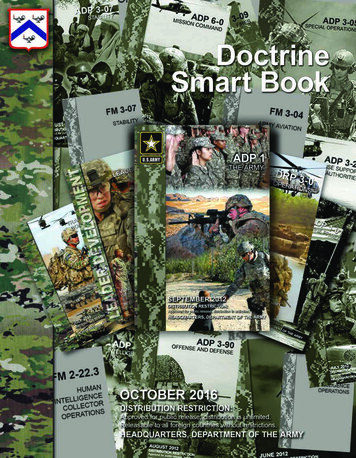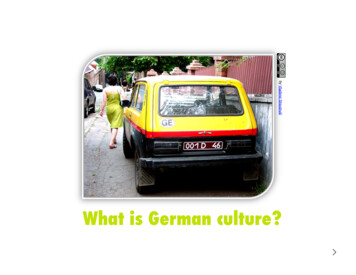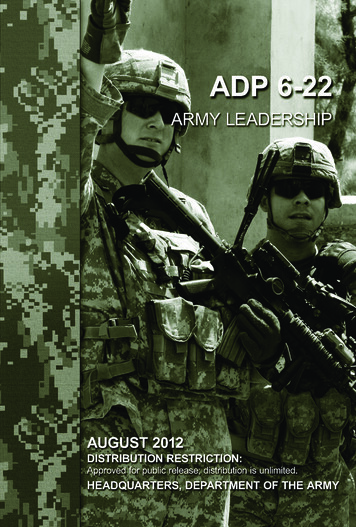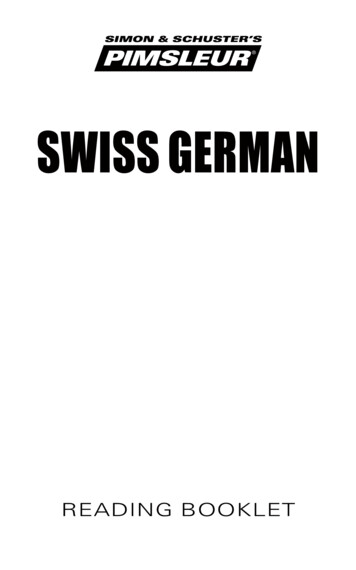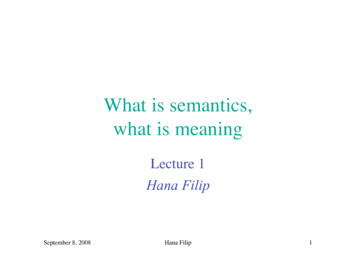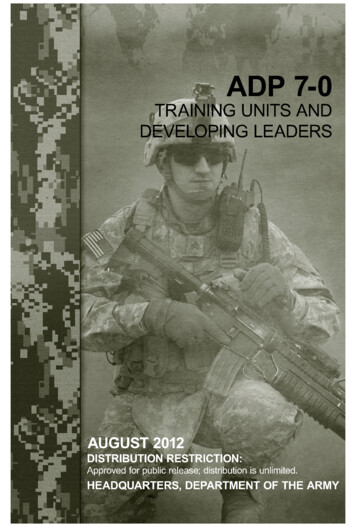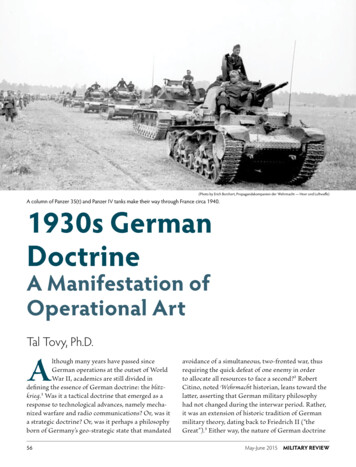
Transcription
(Photo by Erich Borchert, Propagandakompanien der Wehrmacht — Heer und Luftwaffe)A column of Panzer 35(t) and Panzer IV tanks make their way through France circa 1940.1930s GermanDoctrineA Manifestation ofOperational ArtTal Tovy, Ph.D.Although many years have passed sinceGerman operations at the outset of WorldWar II, academics are still divided indefining the essence of German doctrine: the blitzkrieg.1 Was it a tactical doctrine that emerged as aresponse to technological advances, namely mechanized warfare and radio communications? Or, was ita strategic doctrine? Or, was it perhaps a philosophyborn of Germany’s geo-strategic state that mandated56avoidance of a simultaneous, two-fronted war, thusrequiring the quick defeat of one enemy in orderto allocate all resources to face a second?2 RobertCitino, noted Wehrmacht historian, leans toward thelatter, asserting that German military philosophyhad not changed during the interwar period. Rather,it was an extension of historic tradition of Germanmilitary theory, dating back to Friedrich II (“theGreat”).3 Either way, the nature of German doctrineMay-June 2015MILITARY REVIEW
GERMAN OPERATIONAL ARTremains hotly debated among military historians, ascan be observed from the vast amount of literatureavailable. The final word on the matter is yet to besaid, and this article will not attempt to claim it.4However, one oft-contested issue stemming fromdebate and discussion of blitzkrieg is whether theGerman doctrine was conceived as a construct atthe operational level of war. It is this narrower issuewhich is the subject of this article.Shimon Naveh, a well-known Israeli militaryhistorian, disputes the assertion that blitzkrieg was amanifestation of operational art. Instead he describesit as a concept that “not only lacked operationalcoherence but its actual formation dictated relinquishing a systemic approach to military conduct,”and that between 1933 and 1938 the Wehrmachtunderwent a process which systematically destroyedoperational awareness.5 He goes on to assert thatthe essence of the blitzkrieg was mythicized in thewake of the German army’s incredible victories at theoutset of the war, which distorts clear analysis. Thus,Naveh maintains, discussion of operational thinkingis irrelevant in regard to World War II German military thought.6This article will attempt to refute Naveh’s misguided (and misleading) thesis by discussing thetheory and practice of the German army duringthe 1920s and 1930s, proving that both operationalthinking and emphasis on joint operations were verymuch existent in German thinking that led to formulation of blitzkrieg. Moreover, the article will clearlyshow that recognizable operational-based theorywas converted into practice during the campaigns toconquer Western Europe.Operational-Level as ParadigmOne can assert that the very basis for moderncampaign planning and execution lies in developingdoctrine that requires operational thinking and jointoperations. Such doctrine was, in fact, developedduring the second half of the 1930s, the very periodwhen, per Naveh, the Germans deserted operationalthinking. Before detailing the development of operational thinking in German military philosophy, it isnecessary to first provide a short and simple overview of the operational level of war and joint operationsas concepts. Later we shall examine the emergenceMILITARY REVIEWMay-June 2015of German doctrine especially during the periodbetween the close of World War I and outbreak ofWorld War II.Operational Level of WarDefinitionThe U.S. Department of Defense Dictionaryof Military and Associated Terms defines the operational level of war as one at which “campaignsand major operations are planned, conducted, andsustained to achieve strategic objectives” as definedby the political echelon.7 Thus, the operational levelcan be understood as a methodology of commandaimed at executing strategic directives; it is not detached from the strategic level, but rather is subjectto it. Moreover, it is at once the bridge betweenstrategy and tactics, as well as a stage within thestages of war. Also, as art, it should be noted thatthe operational level cannot be analyzed via mathematical or physical means (i.e., the complex systemstheory or chaos theory).8Operational Art as ComplexEndeavor within WarWar is a national effort that requires coordinationfrom the highest level of policy makers to the lowerlevels of tactical execution. This coordination iseffective when every level of command understandsit and does not operate outside the hierarchy, orprovince, of its own prescribed level.The strategic level is born of the complex elements of national power that includes political,economic, social, psychological, and technologicaldomains. Under that construct, military strategyshould be defined as the art and science of using acountry’s military forces to achieve national goalsthrough the use of force, or threat thereof.In contrast, the tactical level of war narrowly focuses on execution of those actions taken by tacticalunits or task forces to conduct actual combat. Theoperational level can be viewed as an intermediaryone that links the two others into a coherent process. Concurrently, the operational level can also bedefined as the mechanism for focusing the strategicperspective on one geographically defined theater inorder to achieve strategic, and, subsequently, national goals by using tactical operations.957
Consequently, for the operational level to beeffective, preparation for war requires a thoroughunderstanding of what the strategic objective is andcomplete understanding of the tactical level, whichrefers to the intricacies of face-to-face confrontationwith enemy forces.The operational level accomplishes its role ofachieving strategic military goals by delegatingtactical tasks to the combat forces; its essence is totranslate strategic targets into achievable tacticalgoals. Simply put, management on the operationallevel boils down to management of a series of battlesfought by the tactical forces to achieve a strategicobjective.10 This can be even further simplified. If thestrategic level is the art of war management and thetactical level is the art of battle management, then theoperational level is the art of campaign management,(i.e., managing a collection of battles).11Additionally, the operational level can be understood as the complex of military actions within agiven theater. Therefore, operational thinking provides the theoretical foundation and logic for jointoperations, defined as cooperation between two ormore of the arms of the armed forces to guaranteeoptimal operational efficiency.12 Such cooperationrequires unity of all efforts. This logically demandsunity of command under one senior headquarters forthe purpose of achieving better command, control,and coordination of all forces and efforts, includingthe non-combat logistics system.Operational Art and JointOperations in the German Militaryin the Interwar PeriodWith the above understanding in mind, analysisof the early World War II German campaigns inconquest of Western Europe has proven valuable forresearchers of operational art. Planning and execution of German operations appear to demonstratethe kind of relationship one should expect betweenthe operational and strategic levels, as well as the keyimportance of joint operations within operationalthinking, thereby making them relevant to this day.Thus, attempts to identify the principles behind, aswell as the theoretic and practical essence of, Germandoctrine continue to interest American militarytheorists who, since the latter half of the 1970s, have58been trying to define and delineate future Americanwarfare doctrine.13 Nevertheless, the theoreticalframework asserted for German thinking continuesto engender an intense debate—as exemplified byNaveh’s objections—regarding whether there actually was conscious employment of something akin tooperational art behind the blitzkrieg concept and theoccurrence of joint operations.14German Operational Warfare inPracticeDuring a preponderance of its early World WarII campaigns, it is unquestionable that Germanyused both its Heer (army) and Luftwaffe (air force)together in combined arms teams, supported byvarious other support arms, to simultaneously attacka vast number of targets while advancing alongseveral routes.15 Additionally, in the occupation ofNorway (Operation Weseruebung), the Kriegsmarine(navy) was also involved in an integrated scheme ofcoordinated operations with the air force and army.The German campaigns manifest identification ofstrategic objectives as they involved intensive planning aimed at identifying a country’s weaknesses,which then became principal targets for the unifiedGerman armed forces (Wehrmacht). Additionally,the campaigns themselves were executed using ahighly flexible, non-central system of command andcontrol.Study of these campaigns reveals that a mission-command-like (Auftragstaktik) structureclearly existed within the German system. This contributed to the operational and tactical flexibility accorded to commanders in the war theater, who wererequired to achieve the general targets defined bythe strategic plan, but left in large measure to theirown initiative to develop and execute their portionof the campaigns.16 The concept of a mission-command-like component signifies operational thinking,since conceptually the operational level operatesalmost independently within the general guidelinesdefined by the strategic level.17This schematic description of operationalthinking illuminates questions such as: Were earlyGerman blitzkrieg successes accidental, or were theythe outcomes of carefully applied theory put intopractice? To elaborate on answers to such questions,May-June 2015MILITARY REVIEW
GERMAN OPERATIONAL ARTwe must examine whether there was something likea concept of operational art involving recognitionfor the need of coordinated joint operations organized in a campaign plan among German armedforces prior to the campaigns in the West.Roots of Operational Art inGerman Military TheoryThe concept of one campaign manager operatingaccording to a set strategic idea while constantlyadapting his actions to the ever changing military-tactical reality of the campaign appears prominently in the observations of Helmuth von Moltke,the Elder.18 He had come to his conclusions in largepart by meticulously studying the campaigns ofFriedrich II and Napoleon. He subsequently usedhis research, while serving as chief of staff of thePrussian army, to adapt management of war in amanner that successfully lead to the unification ofGermany.19Following the triumph of the Prussian statein unification of the German states, von Moltke’simmense influence on German military thinkingcontinued to spread, and indeed shaped the plans ofthe German army leading up to World War I as wellas those during the war itself.20After World War I, the German army continuedto promote operational thinking as one means toeffectively rebuild and restructure its forces in theface of strict limitations placed on it by the Treatyof Versailles. In part to circumvent strictures placedupon German armed forces, German Chief of StaffGen. Hans von Seeckt ordered a systemic study ofWorld War I in an attempt to create a modern warfare theory. A key subject of study was determiningthe appropriate relationship of aerial forces to landforces: Was the Luftwaffe by its nature an independent arm, or should it be subordinate and subject tothe ground forces?21Dominating the debate, Gen. Walther Wever,prominent aviation theorist and the Luftwaffe’s firstchief of staff, asserted that the aerial force was onlya portion of a greater whole, counting for but onethird of Germany’s total military power.22 Therefore,it alone could not win future battles by itself, buthad to be integrated into a system of cooperationwith ground forces (and the navy, to some extent).23MILITARY REVIEWMay-June 2015(Photo courtesy of the Flight Global Archive)A squadron of German Luftwaffe Henschel Hs 123A aircraft flythrough the skies before the Second World War circa 1939.Consequently, he asserted that the air force was notan independent arm, but one which would amplifythe overall power of the German army if used appropriately. In this regard, Wever’s theory is representative of, and differs little from, broad agreementamong military thinkers on the proper role of aerialforces during that period. This view of the Luftwaffe’srelationship with the other arms of service had itsfollowing, even among German aviation officers.24Such theoretical military thinking, along with“war games” with the Soviet Union, producedGermany’s aerial doctrine in 1926. It specified thetwo main roles of the air force. The first was providing close air support (CAS) in support of the otherarms. The second was strategic bombing of enemycities.25The order to establish the Luftwaffe proves thatGermany intended to create a unified military forceunder one command that would coordinate theoperations of all three arms, which were viewed asdependent on each other. According to LuftwaffeRegulation 16, only a joint operation of all three armscould achieve the operational goal (i.e., breaking theenemy’s will to continue fighting).26In 1935, the Luftwaffe updated its 1926 doctrine, Die Luftkriegfuehurung, incorporating some59
(Photo courtesy of the German National Archives)Ruins of destroyed buildings barely remain standing in the aftermath of a German Luftwaffe offensive in Guernica, Spain, circa 1937.additional concepts advocated by Italian theoristJulio Douhet, who asserted that the opening act ofa conflict must be the destruction of the enemy’saerial forces. However, unlike Douhet, who claimedthat the aerial arm should exclusively run the warbecause of its superiority over other arms, Germanthinking continued to maintain that aerial forceswere not superior to the other arms, but coequal, andcodependent.27Between 1933 and 1934, the Truppenfuehrung,the official doctrine of the German army for thefirst years of World War I, was published. It clearlyasserted that the aerial forces played a major rolein land battles, and that aerial assistance to groundforces would improve the combat efficiency ofmilitary operations (synergism). To achieve therequisite mind-set, it enjoined commanders of landforces to obtain a thorough understanding of thedifferent types of aircraft and their capabilities.28Consequently, the Truppenfuehrung can be generally viewed as a document praising and promotingjoint operations.2960Studies examining how the German army progressed during the second half of the 1930s show thatthe German high command made plans and conducted training that was aimed at ensuring officers fromone arm trained with officers of the others to promote familiarity and a penchant for cooperation.30Additionally, starting in 1937, German armed forcesstarted a series of large-scale maneuvers incorporating the three arms.31Though the navy was often incorporated intothis process, jointness was best practiced betweenthe army and air force. The main reason for this wasGermany’s tradition of land force orientation, withthe aerial force viewed as merely an extension ofground warfare.Other reasons can also be found. The first tworelate to the Luftwaffe’s officers: the vast majority ofthem had served in the army prior to being transferred to the air force; additionally, the two armsvery early began exchanging senior officers.32 Athird reason was that ground force military tacticswere taught in Luftwaffe academies. Also, a fourthMay-June 2015MILITARY REVIEW
GERMAN OPERATIONAL ARTreason was that Luftwaffe squadrons were routinelyallocated to the ground forces for CAS purposes.This resulted in German training that emphasizedcooperation between the Luftwaffe and the Panzers(German armored vehicles).The link between the army and the air forcewas further promoted by the emergence of mobilewarfare theory, which had a profound influenceon German ground warfare theorists. As dictatedby British theory—specifically theory developedby Sir Basil H. Liddell Hart—the air force was toact as “flying artillery,” providing assistive fire forrapidly advancing maneuver forces. This was anovel concept when first introduced since it was atime when the majority of maneuver forces werestill horse-drawn and unable to keep up with thefast-paced armored units under development.33However, as Azar Gat proves, Hart greatly influenced the architects of German armored forces,especially Gen. Heinz Guderian.34 Guderian agreedwith Liddell Hart that the tank was the main warplatform when it came to future ground battles, butit could not operate alone. A tank had to be assistedby other mobile forces, especially aircraft.35In his book Achtung Panzer!, Guderian laid out avision that incorporated large formations of rapidlyadvancing tanks, then a new form of warfare, withcooperation and direct support from aerial forces injointly coordinated attacks. He concluded that suchcooperation would enhance combat efficiency in botharms, and neither should be favored over the otherto achieve a new level of battlefield superiority. Onemust look “beyond the interest of an individual armof the service,” Guderian exhorted.36Operational and Joint TheoriesTested during the Spanish Civil WarTheories of warfare and training developed inGermany after World War I were tested during theGerman intervention in the Spanish Civil War.37The use of German forces in the Spanish Civil War,specifically the Luftwaffe, demonstrated quite wellGermany’s operational thinking and joint operations. Between 1936 and 1939, some 20,000 Germansoldiers were sent to Spain for periods ranging fromsix to twelve months. Upon their return to Germany,they imparted their experiences and lessons learnedMILITARY REVIEWMay-June 2015to their home units, which soon incorporated andrefined them in practice.One of the major lessons was the value of providing CAS to ground forces, which was the primemission of the Condor Legion (the German aerialforces in Spain).38 While CAS as a concept had beenevolving in other militaries worldwide, author andair power historian James Corum dubs it integral tothe development of Luftwaffe doctrine.39 It is salient to observe that German CAS expertise priorto involvement in Spain was due to the Luftwaffe’searly commitment through operational thinking tojoint operational planning; the Luftwaffe conductedjoint officer training with ground forces as early as1935.40 Subsequently, the Spanish Civil War providedthe testing grounds for evaluation and adjustmentof CAS in actual conflict, and the results were verypositive. For example, during the 1937 battles withthe Basques, advancing ground forces received highlyeffective CAS in place of artillery assistance. Withpractical experience, the accuracy of ordnance delivery by the Luftwaffe greatly improved, and groundforces learned to efficiently use aerial forces to suppress and destroy obstacles to their forward movement. As a result, Germany’s air and ground forceshad already obtained significant experience with jointoperations tactics before World War II, learning andimproving battle abilities on all levels of warfare.41 Bythe outbreak of World War II, it was clear that thelessons from Spain were well learned.The efficient and deadly assistance supplied by theLuftwaffe for the German ground forces that enabledthe rapid advance of forces in the campaigns forWestern Europe mirrored to a large extent the jointoperations practiced in Spain. Robert L. DiNardo,author of Germany’s Panzer Arm, singles out theGerman army as the one force in Europe that, on theeve of the Poland campaign, practiced a doctrine thatcombined the operations of aerial forces with thoseof maneuver divisions, specifically the armored forces.42 Williamson Murray, author of Luftwaffe, addsthat, on the eve of the Norway campaign, Germany’sarmed forces had achieved total joint operationscapabilities.43 He maintains that the manner in whichthe Luftwaffe was used demonstrated operationalthinking, since on top of CAS, the Luftwaffe was alsotasked with deep strategic bombing strikes against61
enemy targets such as communications lines, recruitment centers, as well as enemy massing of combatand logistics forces. The purpose of these tasks was tosimultaneously destroy enemy forces in close proximity or in contact with German ground forces, aswell as enemy forces in depth, to allow maneuveringforces to move rapidly to their objectives.Additionally, the pre-World War II era saw theemergence of a process of feedback that was the forerunner to what we regard as modern lesson-learnedprocesses within operational thinking. The highercommand, Oberkommando der Wehrmacht (OKW),required joint operations, which demanded creating a theoretical framework. The resulting theorywas tried and tested in training and maneuvers, thelessons from which were used to improve upon jointcapabilities, then tested again in maneuvers.44 Duringthe involvement in Spain and Poland, German unitswere repeatedly hit by Luftwaffe-delivered friendlyfire. Feedback from such events led to steps taken tomitigate command and control problems resulting infratricide. Moreover, joint operation capabilities continued to improve through joint maneuvers, with theLuftwaffe fully committed to this task while planningattacks on the West.45Apart from training and doctrine production,one can also note an important organizationalchange, proof of the German will to improve uponthe joint concept. When the OKW was established in 1938, a high command headed by Hitlerwas formed to coordinate all three arms (Heer,Luftwaffe, and Kriegsmarine).46 Ironically, a schoolin modern American military thinking alleges thatin order to achieve full joint operation capabilitiesand synergic battle efficiency, all American armedforces should be united to form a single arm, whichin a way would mirror the OKW concept. Thus, wecan view the OKW as the essence and beginning ofjoint thinking in Germany that continues to influence modern military theorists concerned withoptimal orchestration of all arms in a unified effortto achieve strategic objectives.ConclusionThis article briefly examined salient events in thedevelopment of German doctrine in the period priorto World War II, demonstrating that it was grounded62in operational-level and joint operations thinking.Such thinking was rooted in German theory andpractical experience dating back to the eighteenthand nineteenth centuries, developed through successive conflicts up through World War I, successfullyadjusted and tested during the Spanish Civil War,and then incorporated into the Wehrmacht planning during the first two years of World War II. Theobservations provided strongly suggest that one ofthe main causes for the absolute success of the earlyGerman campaigns was the use of joint operations asa subset of operational thinking; and, that the speedyconquests during the early part of the war could nothave been possible without it.Moreover, far from lucky improvisation, it wasrooted in consciously and carefully constructeddoctrine developed prior to the war. This can also beproven by contradiction. After the first two years ofthe war, massive damages to its aerial forces prevented Germany from conducting joint operationsresulting in loss of attack initiative.Additionally, military historian Dr. Roger A.Beaumont ascribes the Western adoption of jointoperation tactics as a response to having observed thesuccesses of German joint operations in the West.47 InBritain and the United States, joint operations conducted under an operational-level campaign schemadeveloped on a rapid learning curve, beginning with theNorth Africa campaign and ending with success in thenorthwestern European Theater. Adoption of such wasa key element in the victory over Germany.48 Similarly,American forces in the Pacific—and to a lesser extent,the Russian army—underwent a like process.49To conclude, examining the German operations inthe West by modern-day terms supports the claimthat Germany indeed practiced what we recognizeas operational thinking that necessarily emphasizedthe importance of joint operations. Thus, operations in the early stages of the war were founded ona set theoretical basis, the clearest manifestation ofwhich was the incorporation of an aerial force inGerman joint operations with the army. The essenceof such operational thinking did not come into beingby accident with Hitler’s command to conquer theWest; rather, it was born of theoretical thinkingdeveloped since the nineteenth century and updatedcontinuously to accommodate early technologicalMay-June 2015MILITARY REVIEW
GERMAN OPERATIONAL ARTand theoretical advances in the twentieth century. Therefore, the early success of German operations was not coincidental—it was a result of thedevelopment and incorporation of operationalthinking in the Germany army, well established before World War II.Tal Tovy is an assistant professor in the History Department, Bar Ilan University, Ramat Gan, Israel. He holds aPh.D. in history from the University of Haifa. Dr. Tovy has published extensively on a variety of military historytopics, including the influence of counterinsurgency theory upon American combat operations. His other fields ofinterest include Western military thought, U.S. foreign policy, and U.S. military history. Among the journals he hascontributed articles to are Armed Forces and Society, the Journal of Military and Strategic Studies, the EuropeanJournal of American Studies, and War in History.Notes1. Michael Geyer, “German Strategy in the Age of MachineWarfare, 1914-1945”, Makers of Modern Strategy from Machiavelli to the Nuclear Age, ed. Peter Paret (Princeton, NJ: PrincetonUniversity Press, 1986), 527-97; G. D. Sheffield, “Blitzkrieg andAttrition: Land Operations in Europe 1914-45”, Warfare in theTwentieth Century: Theory and Practice,” eds. Colin McInnes andG.D. Sheffield (London: Routledge, 1988), 67-76.2. James L. Stokesbury, A Short History of World War I (NewYork: William Morrow, 1981), 32-34. German war plans on theeve of WWI determined that France must be defeated within sixweeks, thereafter diverting the German army to the Russian front.3. Robert M. Citino, Blitzkrieg to Desert Storm: The Evolution ofOperational Warfare (Lawrence: University Press of Kansas, 2004),19-20.4. Stephen Morillo, What is Military History? (Malden, MA:Polity Press, 2006), 92-94.5. Shimon Naveh, In Pursuit of Military Excellence: The Evolutionof Operational Art (London: Routledge, 1997), 105-106.6. Ibid., 107.7. Joint Publication ( JP) 1-02, Dictionary of Military and Associated Terms (Washington, DC: U.S. Government Printing Office[GPO], 2003), 387.8. JP 3-0, Doctrine for Joint Operations (Washington, DC: U.S.GPO, 2011), I-12 – I-14.9. Frederick R. Strain, “The New Joint Warfare,” Joint ForceQuarterly 2 (1993): 20.10. Antoine Henri De Jomini, The Art of War, trans. G. H.Mendell and W. P. Craighill (originally published in English in1862; republished by [TX: El Paso Norte Press, 2005]), 140-141;Clayton R. Newell, “What is Operational Art?” Military Review 70(9)(1990): 3-7. See the relevant discussion in Jomini regarding thetension between war and battle. This tension, per Jomini, createda new level he dubbed “Grand Tactics,” mediating between thegoals of war and battle management.11. John English, “The Operational Art: Developments inthe Theories of War,” The Operational Art: Developments in theTheories of War, eds. B.J.C. McKercher and Michael A. Hennessy(Westport, CT: Praeger, 1996), 7-20.12. JP 1-02, 279; JP 3-0, I-1 – I-2; Field Manual (FM) 1, TheArmy (Washington, DC: U.S. GPO, 2001), 19-20.MILITARY REVIEWMay-June 201513. John W. Woodmansee, “Blitzkrieg and the AirLandBattle,” Military Review 64 (8)(1984): 21-39. This articlediscusses how German doctrine affected American militarytheory; Archie Galloway, “FM 100-5: Who Influenced Whom?”Military Review 66 (3)(1986): 46-57. As Galloway notes, no onedoctrine reigns supreme, and that various military theoristsinfluence American operational art, making it a synthesis ofseveral theories; Shimon Naveh, In Pursuit of Military Excellence(London: Routledge, 1997), 250-251. Naveh, an admirer ofthe Soviet doctrine, dismisses Galloway’s essay (although hequotes from other essays in the very same issue). He claims thatAmerican military thought was largely influenced by the DeepBattle theory; FM 100-5, Operations (Washington, DC: U.S.GPO, 1993), 6-2; FM 100-2-1, The Soviet Army: Operations andTactics (Washington, DC: U.S. GPO, 1984). FM 100-5 tips thescales in favor of Galloway. One can recognize a great numberof modern military theories, and even the subtle influenceof ancient Chinese philosopher Sun Tzu. Naturally, FM 100-5holds some original thought resulting from understanding thenew political-strategic reality faced by the United States afterthe Vietnam War (1982 edition), and more clearly with the endof the Cold War (1993 edition). One can say that the Americanmilitary indeed study Soviet war theory, but as can be gleanedfrom the FM 100-2 series, The Soviet Army, it did so in orderto prepare for a future confrontation with the Soviet army inCentral Europe, a form of know thy enemy; Walter E. Kretchik,U.S. Army Doctrine: From the American Revolution to the Waron Terror (Lawrence, KS: University Press of Kansas, 2011),226-232.14. Kretchik, 197-217; Adrian R. Lewis, The American Culture of War: The History of U.S. Military Forces from World WarII to Operation Enduring Freedom, (London: Routledge, 2012),294-302.15. Citino, 42.16. Richard D. Hooker, “Operation Weserübung and theOrigins of Joint Warfare”, Joint Force Quarterly 1 (1993): 110.17. Michael D. Krause, “Moltke and Origins of the Operational Level of War,” Historical Perspectives of the OperationalArt, eds. Michael D. Krause and R. Cody Phillips (Washington,DC: U.S. GPO, 2005), 134,
Jun 30, 2015 · 1930s German Doctrine A Manifestation of Operational Art Tal Tovy, Ph.D. A lthough many years have passed since German operations at the outset of World War II, academics are still divided in defining the essence of German doctrine: the blitz-krieg.1 Was it a tactical doctrine that emerg
